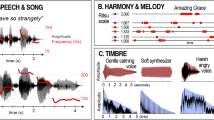Abstract
This article will focus on the relationship between tempo and temperament and the power of music to facilitate healing, especially for individuals who struggle with temperament or mood disorders, by examining briefly how individuals diagnosed with depression may be helped by listening to or performing music as a form of treatment. Current research into the “science” of music is providing concrete evidence for the reality that musicians and music therapists have long intuited to be true–music does have the capacity to facilitate healing by influencing brain activity and altering moods (Cambell and Doman 2011; Levitin 2007, 2008; Mannes 2011; Powell 2010; Pruyser 1983; Rose 2004). Insofar as music is an integral part of most worship traditions, it provides a common ground for conversation that may seem more natural and less formidable to ministers and lay people alike than the structures of conventional counseling or care-giving relationships, especially for those who have a tendency to be suspicious of all things psychological.
Similar content being viewed by others
References
American Psychiatric Association. (2013). Diagnostic and statistical manual of mental disorders (5th ed.). Arlington, VA: American Psychiatric Association.
Campbell, D. (1997). The Mozart effect®: Tapping the power of music to heal the body, strengthen the mind, and unlock the creative spirit. New York: Avon Books.
Campbell, D., & Doman, A. (2011). Healing at the speed of sound: How what we hear transforms our brains and our lives from music to silence and everything in between. New York: Hudson Street Press.
Evangelical Lutheran worship. (2006). Minneapolis: Augsburg Fortress.
Freud, S. (1922). Psycho-Analysis. Standard edition, 18, 235–254.
Knoblauch, S. H. (2000). The musical edge of therapeutic dialogue. Hillsdale, NJ: The Analytic Press.
Kugel, J. L. (2011). In the Valley of the Shadow: On the Foundations of Religious Belief. New York: Free Press.
Levitin, D. J. (2007). This is your brain on music: The science of a human obsession. New York: Plume/Penguin.
Levitin, D. J. (2008). The world in six songs: How the musical brain created human nature. New York: Penguin.
Long, T. G. (2009). Accompany them with singing: The Christian funeral. Louisville: Westminster John Knox.
Mannes, E. (2011). The power of music: Pioneering discoveries in the new science of song. New York: Walker & Co.
Powell, J. (2010). How music works: The science and psychology of beautiful sounds, from Beethoven to the Beatles and beyond. New York: Little, Brown & Co.
Pruyser, P. W. (1983). The play of the imagination: Toward a psychoanalysis of culture. New York: International Universities Press.
Rose, G. J. (2004). Between couch and piano: Psychoanalysis, music, art and neuroscience. New York: Brunner-Routledge.
Schwarz, D. (1997). Listening subjects: Music, psychoanalysis and culture. Durham: Duke University.
Schweitzer, C. S. (2011). Text and tune, speaking and listening: musical resources in pastoral care. Pastoral Psychology, 60, 311–321.
Schweitzer, C. S. (2014). (2014). Psalms as resources for pastoral care. In William P. Brown, The Oxford Handbook on the Psalms. New York: Oxford University Press.
Shorter Oxford English dictionary. (2007). 6th ed. New York: Oxford University. Wooten, V. L. (2006). The music lesson: A spiritual search for growth through music. New York: Berkley Books/Penguin.
Author information
Authors and Affiliations
Corresponding author
Rights and permissions
About this article
Cite this article
Schweitzer, C.L.S. Tempo and Temperament: A Music Lesson on the Significance of Time for the Art of Pastoral Care. Pastoral Psychol 63, 719–734 (2014). https://doi.org/10.1007/s11089-014-0613-5
Published:
Issue Date:
DOI: https://doi.org/10.1007/s11089-014-0613-5




